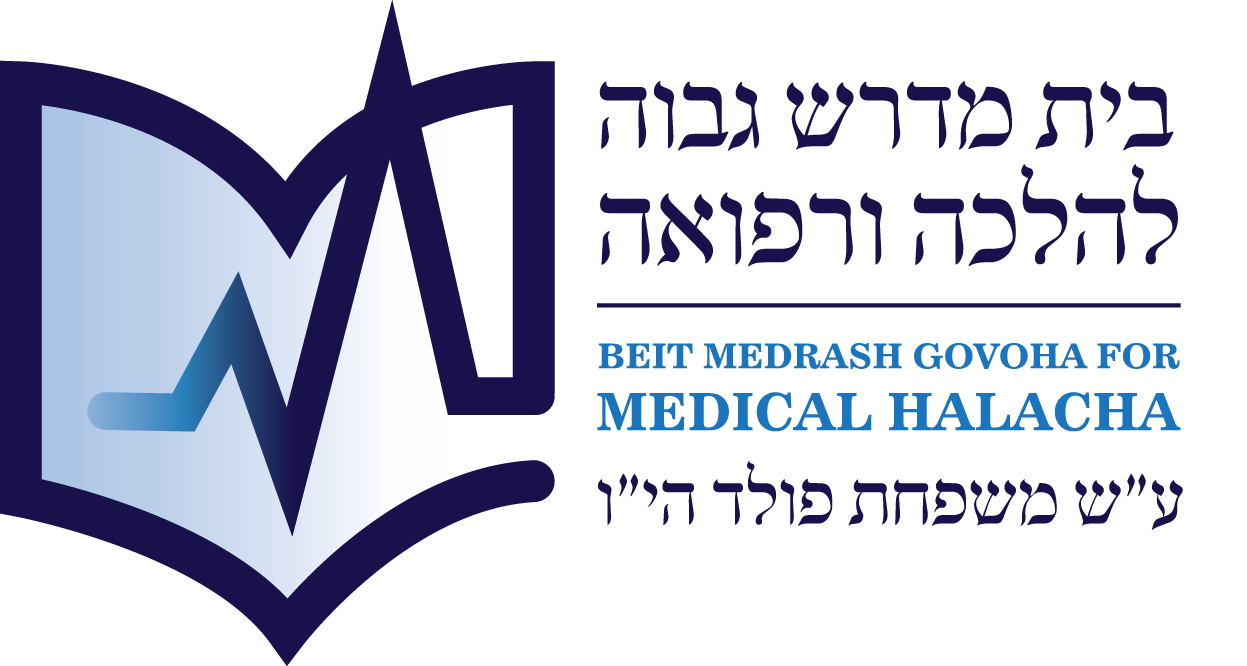Patients receiving cancer treatment frequently experience hair loss, which can present various halachic challenges. For example, we have previously examined the permissibility of permanent eyebrow makeup in these situations.[1] This essay will explore whether a permanent wig constitutes a Chatzitza for Tevila.
Unlike regular wigs placed on top of natural hair and held in place with bands or clips, permanent wigs are placed directly on the scalp and attached with a special medical adhesive, usually hypoallergenic. This ensures that the wig is securely fixed and preserves a natural look. These wigs can be particularly advantageous for married women who are meticulous about covering their hair.
The wig is removed periodically (as often as every few weeks), depending on the type and quality of the adhesive and the wig. The scalp is cleaned, and the wig is reattached. This process requires expertise and is generally performed by a professional to prevent skin damage and discomfort from an overly tight attachment.
The Halachic question is: does a permanent wig constitute a Chatzitza for Tevila?
There are several sources in Chaza”l that indicate that we are especially stringent regarding Chatzitzos on the head:
Sukka 6b: According to Torah law, [if something covers] most [of the body] and the person is particular about it, it is a Chatzitza; if he is not particular about it, it is not. But the Chachamim decreed that something that covers most of the body [is a Chatzitza] even when he is not particular, due to the case where he is particular, and [something that covers] a minority of the body when he is particular [is a Chatzitza], due to the case where it covers most of the body and he is particular.
In other words, two criteria must be considered to determine whether something constitutes a Chatzitza: does it cover most of the body, and is it something that the individual would typically want to remove? Meeting either criterion suffices for it to be considered a Chatzitza. Consequently, only a minority of the body that one is not particular about (Mi’ut sheEino Makpid) is not considered a Chatzitza.
The Rambam codifies this Halacha (Hilchos Mikva’os 2:15):
If two or more hairs are tied together in one knot, it is not a Chatzitza because water can penetrate. But a single hair that is knotted is a Chatzitza if the person is Makpid about it. If he is not Makpid, the Tevila is valid unless most of his hair is tied, hair by hair. This is the ruling of the Ge’onim.
But it appears to me that a person’s hair is considered like his body regarding Tevila, and not like a separate entity that would be subject to the “majority” rule. Therefore, even if all the hair is tied hair by hair, if he is not Makpid about it, the Tevila is valid – unless this joins with another Chatzitza on his body, in which case the total becomes a Chatzitza on most of his body, as we explained. This applies to a Nida and other Tamei people with hair on their heads.
The Ra’avad objects to the Rambam’s ruling and sides with the Ge’onim. Stated simply, there is a Machlokes Rishonim whether the Chatzitza d’Oraisa of Rubo haMakpid and Chatzitza d’Rabbanan of Rubo sheEino Makpid apply to the entire body as a whole or if the Halacha views the body and the hair as separate entities.
According to the Ge’onim, if most of the hair is obstructed (e.g., tied hair by hair), it is a Chatzitza, even if there are no other barriers on the rest of the body. The Rambam disagrees and holds that the barrier must cover most of the body to be considered a Chatzitza. The Ra’avad agrees with the Geonim.
The Poskim (see the Gra to Y.D. 198) cite the Gemara in Bava Kama (82a)[2] as evidence for the Shita of the Ge’onim. The Beis Yosef asserts that this reflects the opinion of most Poskim (including Rabbenu Yerucham and the Rosh) and rules accordingly in the Shulchan Aruch (198:5). Conversely, the Kol Bo (86) seems to agree with the Rambam, similar to the Meiri (Mikva’os 9:3) and Rashbatz (Niddah 67). The Aruch haShulchan (25) maintains that this is the opinion of the Tur. Therefore, the Rambam’s opinion is not a Shitas Yachid and can be considered a supporting position for leniency in some instances.
For a cancer patient with a wig, there is no Chatzitza in the hair itself, as no natural hair is present. The question is, what is the status of the area where hair typically grows with respect to a Chatzitza?
There are three explanations of the Ge’onim’s position:
- The Brisker Rav (beginning of Hilchos Mikva’os) explains that hair and the body are treated as separate entities in all areas of Torah law.
- The Ritva, explaining the view of Rashi, says this is simply a Halacha l’Moshe miSinai. See also the Or Sameach (Isurei Bi’ah 4:2)
- The Ran in Eruvin explains that there are two separate Drashos: the law of a Chatzitza on the body is derived from the Pasuk: “He shall wash all of his flesh in water” (Vayikra 15:16). Chaza”l further expound that the law extends to what is secondary to the flesh – specifically, the hair. As two different sources are necessary to teach us about a Chatzitza in the hair, the Ge’onim understood that the hair should be treated as distinct from the rest of the body.
Given these reasons, the scalpshould be considered no differently than any other body area, as the Chiddush of the Ge’onim pertains only to the hair. The Brisker Rav holds that only hair is distinguished from the rest of the body when evaluating the proportion covered by a Chatzitza. According to the Ritva, the Halacha l’Moshe miSinai is exclusive to hair, and, according to the Ran, the Drasha of “that which is secondary to his flesh” refers specifically to hair, and not to the scalp where it normally grows.
The Poskim also discuss whether the Ge’onim consider all the body hair collectively. That is, must most of the hair on the body be obstructed to be a Chatzitza, or do we view each collection of hair (e.g., on the scalp) independently? According to the latter possibility, if most of the hair in a specific location (e.g., the head) was obstructed, it would be considered a Chatzitza even though the obstruction does not involve more than fifty percent of the person’s body hair.
The Chochmas Adam[3] (119:5) implies that each area containing hair should be measured separately; if the majority of hair in a given region is covered or obstructed, it constitutes a Chatzitza. The Sidrei Tahara[4] (Y.D. 198:17) references this view of the Tiferes l’Moshe[5], albeit noting that the matter is unresolved. Similarly, the Prisha[6] expresses uncertainty regarding the definitive Halacha.
The Aruch haShulchan (25) and Chochmas Adam (3) rule stringently, while the Pardes Rimonim[7] is lenient.
A third approach is presented by the Mahara”l Tzintz[8] in Shu”t Meshivas Nefesh (12:9), who asserts that the Shita of the Ge’onim pertains only to hair on the head due to its significance. In contrast, all other body hair is considered like the body itself. Additionally, he appears to consider the scalp of a bald woman as a distinct area. The Avnei Shoham (p807) cites additional Poskim who agree with the first contention. However, both authorities hold that for men, the scalp is the same as the rest of the body.
It is apparent that the Poskim who discuss whether to aggregate all body hair when determining whether it constitutes a majority disagree with Mahara”l Tzintz’s approach. They treat hair as a distinct category; the head itself has no special status. This distinction is clear from both opinions – those who consider all hair collectively and those who assess the hair on the head independently – as neither approach attributes particular significance to the place of the hair, contrary to Mahara”l Tzintz. Instead, they focus solely on whether hair in a specific area should be evaluated independently.
A related essay by R’ Gavriel Toledano in Asya (85–86) cites the Kinas Sofrim[9] who rules that when a Chatzitza in the hair originates from an external source, rather than from the hair itself, according to both the Rambam and Ge’onim, the standard applied is the majority of the body, without regard for the majority of the hair. The case discussed by the Poskim is when the hair itself is knotted, not when an external object is attached to the scalp or hair. R’ Toledano infers from this that we only treat the hair as a separate entity, not the place of the hair. If the scalp had a different status from the rest of the body, why would the source of the Chatzitza matter? This conclusion is further supported by the argument that even when a strand of hair is knotted, there is no obstruction to the scalp; the Chatzitza is only within the hair itself.
Based on the foregoing analysis, it appears that when there is no hair on the scalp, the majority of Poskim would not consider an attached wig to constitute a Rov.
Cancer patients often retain some hair, leading to the question of whether a few remaining hairs qualify as “Rov of the hair”, or if we define “Rov” relative to the typical amount of hair. The first view seems more plausible – that even a few hairs are enough to count as the basis for the Rov rule – so all hair should be removed before attaching the wig.
Moving on to whether this type of hairpiece would be considered a Chatzitza mid’Rabbanan of Mi’ut haMakpid, we must engage in a broader Halachic discussion of what qualifies as Eino Makpid. Specifically, is anything a person plans to remove deemed “Makpid” since he intends to remove it eventually?
In this case, the woman removes and reattaches the wig every few weeks, and she hopes that her hair will grow back and she will no longer need the wig at all.
Regarding the first point, we must consider how long the wig will remain attached. There is a Machlokes haPoskim as to how long something needs to be attached (usually for medical purposes) for it to be considered permanent and not a Chatzitza. See Shu”t Avnei Nezer[10] (Y.D. 262) and Shu”t Chelkas Yoav[11] (Y.D. 7).
If the attachment remains in place for several months, there is considerable room for leniency, as numerous Poskim consider such items nullified and subordinate to the body. Some Poskim rule that even if a bandage is replaced regularly, it may still be considered permanent rather than a Chatzitza.
As to the second point, one must consider that there is no definitive timeline for when she might be able to remove the wig, even if she expects it to happen eventually.
It is essential to recognize that the woman wishes to have the wig in place at this time. This situation differs from bandages, which, though necessary, are generally undesirable and usually removed as soon as they are no longer needed. In this case, using the wig is elective and motivated by aesthetic or social considerations rather than medical necessity.
There are three opinions among the Poskim:[12]
- The Nishmas Avraham[13] (2, p265), quoting R’ Yehoshua Neuwirth zt”l[14], rules stringently, forbidding Tevila while wearing the glued wig. This is because the wig covers the entire head and the Chochmas Adam (119, end of 3) rules that if all the hair is covered, even if one is not Makpid, it constitutes a Chatzitza mid’Oraisa.
[See also the Binas Adam (ibid. 12) that substantive cosmetic coloring does not constitute a Chatzitza since a person is not Makpid. This implies that if it does cover the Rov, it is a Chatzitza. See also Shu”t Bigdei Yesha[15] (Y.D. 23) who rules that any covering over the entire hair is a Chatzitza even if it is for aesthetic purposes.]
However, as explained above, it would seem that only the hair itself is treated separately and judged by the Rov standard, even in the case of Eino Makpid. In such a case, it is a Chatzitza d’Oraisa when completely covered. But if all of the hair has fallen out and there are not even a few hairs remaining, then the head is not judged independently, and even a total covering remains a Mi’ut. See Orchos Chaim (Hilchos Taharas haNiddah Siman 10, end of Se’if 8), Shiurei Tahara[16] (p355), Avnei Shoham (2, p807).
- The Darchei Tahara[17] (p211) rules that one must consult a Moreh Hora’ah. Apparently, he held that each case should be judged individually.
- Some Poskim permit Tevila with a glued wig; see the Avnei Shoham (ibid.) This is also the conclusion of R’ Toledano above. See also the Miluim in Avnei Shoham (p36), where the author discusses a woman with hair loss who wears a special mesh secured to her scalp with hair woven into it. The adhesive is effective for about five weeks, after which it is removed and reattached. He rules leniently because the wig is used for aesthetic purposes. Even though the Chatzitza has substance and hair is considered independently, such that a Chatzitza b’Rubo is d’Oraisa even if Eino Makpid, an object applied for aesthetic reasons is treated like the body itself, not a foreign item.
He adds that even if her Tevila night happens to be immediately after the removal of the wig, and it would be easy to reattach it the following day, if she is ashamed to be seen without it, she may Tovel with it. See Shu”t Pnei Aryeh[18] (6) who rules that something worn for beauty is not a Chatzitza even if it covers the entire hair, since it is considered part of the body. See also Chut Shani[19] (p308), Pischei Da’as (Chapter 28, footnote 15).
See also Shu”t Igros Moshe (Y.D. 3:62) regarding artificial eyelashes glued with strong adhesive such that they cannot be removed and eventually fall out. He rules that leChatchila one should not apply them unless she would be unattractive to her husband without them. But if she has already applied them and cannot remove them, she is permitted to Tovel with them.
[1] “Are Those Eyebrows Real?”, Eikev 5781
[2] The Gemara there records the Takanos of Ezra haSofer, including the requirement for a woman to perform Chafifa (combing the hair) in preparation for Tevila. The Gemara says that mid’Oraisa, a woman must inspect her hair before Tevila to make sure that no hairs are knotted together and that there is nothing repulsive to ensure there is no Chatzitza. Ezra added the requirement that a woman comb her hair before Tevila.
[3] R’ Avraham Danzig zt”l of Vilna (1748-1820)
[4] R’ Elchanan b. Shmuel Zanvil Ashkenazi zt”l (1713-1780)
[5] R’ Moshe zt”l b. Avraham miGeza Tzvi Hy”d (d. 1681).
[6] R’ Yehoshua Falk Katz zt”l (c. 1555–1614)
[7] R’ Yoel b. Meir Katz Hy”d (1890-1944)
[8] R’ Aryeh Leib Tzintz zt”l (c.1768-1833)
[9] R’ Shlomo Kluger zt”l (1785-1869)
[10] R’ Avrohom Borenstein zt”l (1838-1910)
[11] R’ Yoav Yehoshua Weingarten zt”l (1845-1923). The Chelkas Yoav was a Talmid of the Avnei Nezer.
[12] These have been summarized by R’ Chananel Helbrun, a member of our Beis haMedrash, in a Kuntres on the subject.
[13] R’ Dr. Avraham Sofer Avraham amus”h (1935-)
[14] 1927-2013
[15] R’ Shmuel b. Yosef haLevi m’Bialystok. This Sefer was published in Vilna in 1844.
[16] R’ Mordechai b. Tzadok Gross shlit”a (1950-)
[17] R’ Mordechai Eliyahu zt”l (1929-2010) served as the Rishon l’Tzion from 1983-1993.
[18] R’ Aryeh Leib Breslau zt”l (1741-1809)
[19] R’ Shmaryahu Yosef Nisim Karelitz zt”l (1926-2019)











Add comment